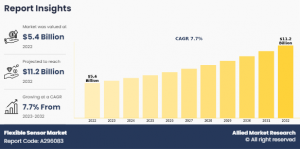Flexible Sensor Market Set for Rapid Growth During 2022 – 2032
Flexible Sensor Market Expected to Reach $11.2 Billion by 2032
Request for Sample PDF: https://www.alliedmarketresearch.com/request-sample/A296083
A flexible sensor is a type of sensor that is designed to be bendable, stretchable, or conformable to various shapes and surfaces. Unlike traditional rigid sensors, flexible sensors are made from materials that allow them to be integrated into curved or flexible surfaces without compromising their functionality. These sensors are often created using printing techniques that allow the deposition of conductive materials (such as conductive inks) on flexible substrates.
The flexible sensor market growth projections scalability of printed electronics is a significant driver. Manufacturers can scale up production easily, enabling mass production of flexible sensor market share to meet increasing demand. This scalability is crucial for applications such as wearable devices, IoT (Internet of Things) devices, and other emerging technologies where large quantities of sensors are needed. Printed electronics utilize cost-effective manufacturing processes, such as screen printing, inkjet printing, and roll-to-roll printing.
These techniques allow for the deposition of electronic materials on flexible substrates at a lower cost compared to traditional rigid electronics manufacturing. This cost efficiency makes flexible sensors more economically viable, thereby driving their adoption across various industries. Flexible sensors, enabled by printed electronics, are inherently thin and lightweight. This characteristic is particularly advantageous in applications where space and weight constraints are critical, such as wearable health monitoring devices, smart textiles, and flexible electronics. The thin and lightweight design also enhances the flexibility and conformability of sensors to various surfaces.
The absence of industry-wide standards can impede the smooth integration of flexible sensor technologies into existing systems and platforms. This integration difficulty may result in higher costs and longer development times for manufacturers and developers aiming to incorporate flexible sensors into their products. Without standardized protocols and specifications, different flexible sensor technologies may struggle to communicate and work seamlessly with each other.
Get a Customized Research Report @ https://www.alliedmarketresearch.com/request-for-customization/A296083
This lack of interoperability can limit the potential applications and integration of flexible sensors into various systems. Industries that require diverse sensor types may find it challenging to adopt flexible sensors if they do not adhere to common standards. Standardization processes take time, and the absence of established standards can slow down the overall development cycle of flexible sensor applications. Companies may need to invest additional resources in navigating the complexities of non-standardized technologies, potentially delaying the time it takes to bring products to market.
The flexible sensor industry can be used for in-cabin monitoring to enhance occupant safety. The flexible sensor industry can detect and analyze various parameters such as occupant presence, posture, and vital signs. In the event of an accident, this information can be utilized to deploy airbags more intelligently and improve overall safety. Flexible sensor market statistics can be integrated into the steering wheel, seats, and dashboard to monitor the driver's attention and alertness. DMS can contribute to advanced driver assistance systems (ADAS) by providing real-time data to prevent accidents caused by driver distraction or fatigue. Flexible sensors in seats can accurately detect seat occupancy, allowing for optimized airbag deployment. Flexible temperature sensors play a crucial role in healthcare, particularly in remote patient monitoring and medical diagnostics. Flexible temperature sensors are also used in various consumer electronic devices such as smartphones, laptops, and tablets.
This helps enhance safety by ensuring that airbags are deployed with the appropriate force based on the size and position of the occupant. The lightweight nature of flexible sensors contributes to overall weight reduction in vehicles, positively impacting fuel efficiency. This is crucial for meeting fuel economy standards and reducing environmental impact. Flexible sensors, designed with durable materials, can withstand the dynamic conditions within a vehicle, including vibrations and temperature fluctuations. This ensures long-term reliability and reduces maintenance requirements. In healthcare, flexible and stretchable sensors have immense potential for applications such as continuous health monitoring, remote patient monitoring, and biomedical diagnostics.
The flexible sensor market segmentation is based on product type, end-user, and region. Based on this, it is classified into a flexible pressure sensor and a flexible gas sensor. Based on this, it is segmented into industrial, consumer electronics, medical, and automotive.
Based on, flexible sensor market size is analyzed across North America (the U.S., Canada, and Mexico), Europe (the UK, Germany, France, Italy, spain and rest of Europe), Asia-Pacific (China, India, Japan, South Korea, Australia and rest of Asia-Pacific), LAMEA (Brazil, Saudi Arabia, UAE, South Africa, and Rest of LAMEA).
Enquiry Before Buying: https://www.alliedmarketresearch.com/purchase-enquiry/A296083
Key findings of the study
- In 2022, by product type, the flexible pressure sensor segment was the highest revenue contributor to the market, with $3001.6 million in 2022, and is estimated to reach $6531.4 million by 2032, with a CAGR of 8.2%.
- By end-use, the medical segment was the highest revenue contributor to the market, with $1883.00 million in 2022, and is estimated to reach $3461.2 million by 2032, with a CAGR of 6.4%.
- By region, Asia-Pacific was the highest revenue contributor, accounting for $1849.4 million in 2022, and is estimated to reach $3950.2 million by 2032, with a CAGR of 8.0%.
The key players profiled in the rock drilling equipment market report include FlexEnable Limited, Brewer Science, Inc., Interlink Electronics, Inc., Peratech Holdco Ltd, TE Connectivity, Bloodhound Technology, Soft Materials, Integrated Device Technology, KEMET Corporation, and ELMOS Semiconductor SE.
About Us:
Allied Market Research is a leading provider of market intelligence, offering reports from top technology publishers. Our in-depth market assessments in our research reports take into account significant technological advancements in the sector. In addition to other areas of expertise, AMR focuses on the analysis of high-tech systems and advanced production systems. We have a team of experts who compile thorough research reports and actively advise leading businesses to enhance their current procedures. Our experts have a wealth of knowledge on the topics they cover. Also, they use a variety of tools and techniques when gathering and analyzing data, including patented data sources.
David Correa
Allied Market Research
+ 1800-792-5285
email us here
Visit us on social media:
LinkedIn
Facebook
YouTube
X
Legal Disclaimer:
EIN Presswire provides this news content "as is" without warranty of any kind. We do not accept any responsibility or liability for the accuracy, content, images, videos, licenses, completeness, legality, or reliability of the information contained in this article. If you have any complaints or copyright issues related to this article, kindly contact the author above.
Recruit Umeda by Good Place Wins Silver in A' Interior Design Awards
Penutupan Tambang di Raja Ampat Soroti Isu ESG dan Arah Kebijakan di Pasar Nikel - Laporan EBC Financial Group
Cairns Auto Works Launches Same-Day Roadworthy Certificates—A First for Cairns Drivers
Więcej ważnych informacji
 Jedynka Newserii
Jedynka Newserii

 Jedynka Newserii
Jedynka Newserii

Polityka

Unijne mechanizmy ułatwiają zwiększenie wydatków na obronność przez europejskie kraje NATO. Ważnym aspektem infrastruktura podwójnego zastosowania
Wydatki na obronność w krajach NATO mają wzrosnąć do 2035 roku do 5 proc. PKB. W dużej mierze będzie to możliwe dzięki Unii Europejskiej, która stworzyła ramy umożliwiające krajom członkowskim realizację celów NATO w zakresie obronności, nie tylko poprzez finansowanie i inwestycje, ale także poprzez elastyczność budżetową. – To pełna synergia, można powiedzieć, że Unia Europejska współfinansuje razem z państwami członkowskimi cele zdolnościowe NATO – ocenia Paweł Zalewski, sekretarz stanu w Ministerstwie Obrony Narodowej.
Ochrona środowiska
Rusza budowa lądowej infrastruktury dla projektów Bałtyk 2 i Bałtyk 3. Prąd z tych farm wiatrowych popłynie w 2027 roku

Ruszyła budowa lądowej infrastruktury dla morskich farm wiatrowych Bałtyk 2 i Bałtyk 3 rozwijanych przez Equinor i Grupę Polenergia. To przede wszystkim baza serwisowa w Łebie i dwie stacje elektroenergetyczne. Jednocześnie trwają przygotowania do rozpoczęcia prac na morzu. Pierwszy prąd z obu projektów popłynie w 2027 roku, a w kolejce czeka morska farma wiatrowa Bałtyk 1 – największy i najbardziej zaawansowany projekt II fazy rozwoju offshore.
Edukacja
Uczelnie zaczynają wspólnie walczyć ze zjawiskiem mobbingu i dyskryminacji. Ruszają badania nad skalą problemu

Szkoły wyższe chcą aktywniej walczyć ze zjawiskiem mobbingu i dyskryminacji zarówno wobec pracowników, jak i studentów. W ramach projektu Bezpieczna Uczelnia będą się wymieniać dobrymi praktykami w zakresie polityki antymobbingowej. Zostaną przeprowadzone także badania na temat obecnej sytuacji w środowisku akademickim. Dotychczasowe badania prowadzone przez Fundację Science Watch Polska wskazują, że mobbing to dość powszechne zjawisko na uczelniach, które przybiera charakterystyczne dla środowiska formy.
Partner serwisu
Szkolenia

Akademia Newserii
Akademia Newserii to projekt, w ramach którego najlepsi polscy dziennikarze biznesowi, giełdowi oraz lifestylowi, a także szkoleniowcy z wieloletnim doświadczeniem dzielą się swoją wiedzą nt. pracy z mediami.








.gif)

 |
| |
| |
|